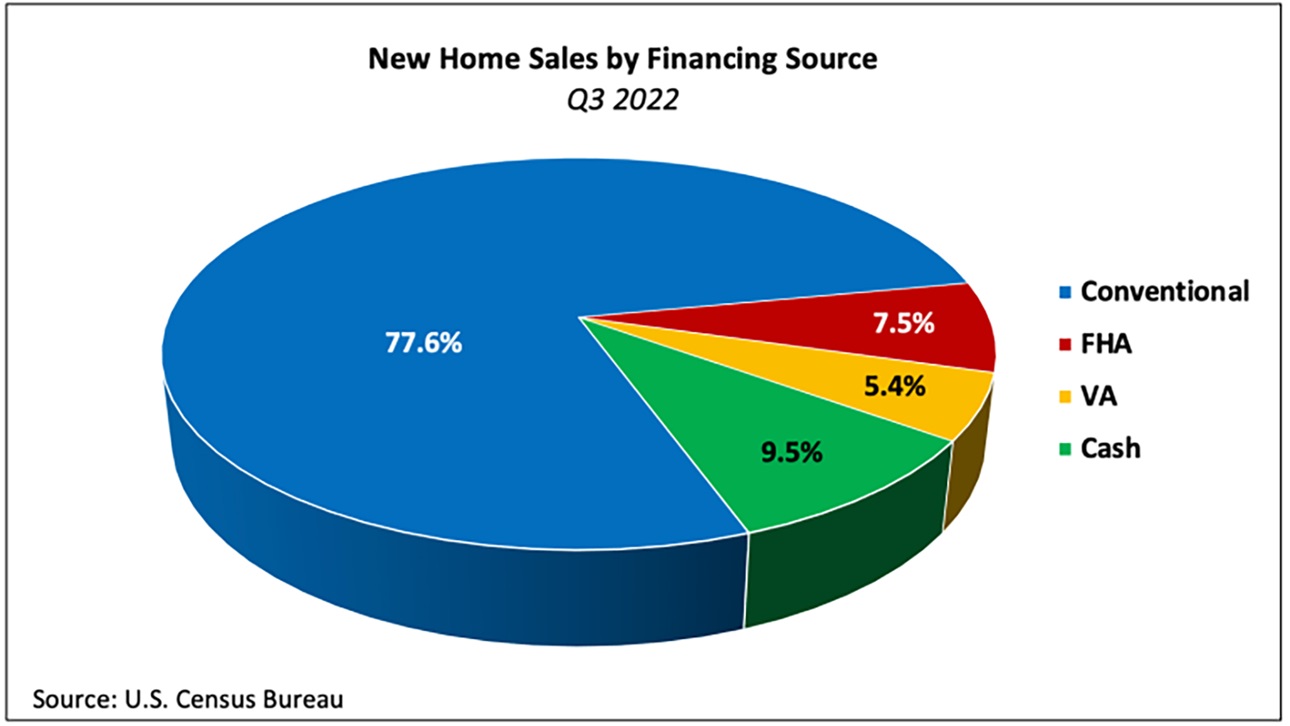All-Cash New Home Sales Outnumber FHA-Backed for the First Time Since 2007

NAHB analysis of the most recent Quarterly Sales by Price and Financing published by the U.S. Census Bureau reveals that more homes were bought in the third quarter of 2022 using cash than were financed through FHA loans for the first time since 2007.
The share of cash purchases has climbed each of the past three quarters to reach a 20-year high of 9.5% (14,000 sales).
In contrast, new home sales financed through the Federal Housing Administration (FHA) numbered 11,000 and accounted for 7.5% of total sales in the third quarter of 2022 — the smallest share since the fourth quarter of 2007. The share has dropped by nearly two-thirds since the spring of 2020.
Other sources of financing include:
- Conventional loans, which financed 77.6% of new home sales in the third quarter. This represents a 1.2 percentage point quarter-over-quarter increase, and the share has risen each of the prior seven quarters.
- VA-backed sales, the share of which declined 0.8 percentage point to 5.4% in the third quarter but is 0.8 percentage points higher than the share one year prior.
In the second quarter, the national median sales price of a new home was $454,900. The median new home price has increased 5% in 2022, but there is a large variance by type of financing. The price of a new home purchased with cash has increased 27.3% since the first quarter of 2022, while the price of an FHA-backed sale has fallen 7.6%.
Split by types of financing, the median prices of new homes were:
- Conventional loans — $503,200
- FHA loans — $340,300
- VA loans — $432,200
- Cash — $494,200
Although cash sales typically make up a small portion of new home sales, they constitute a larger share of existing home sales. According to estimates from the National Association of REALTORS, 22% of existing home transactions were all-cash sales in September 2022, down from 24% in August 2022 and 23% in September 2021.
David Logan, director of tax and trade policy analysis, details key factors contributing to these dynamics in this Eye on Housing post.
Latest from NAHBNow
Dec 23, 2025
The 5 Types of Builders — and the One Built to ProsperMost builders want the same things: predictable profits, less stress, and a business that doesn’t grind them down year after year.
Dec 23, 2025
Lumber Capacity Has Peaked for 2025An annual revision to the Federal Reserve G.17 Industrial Production report shows current sawmill production levels above 2017 by 7.5%, but just 0.3% above 2023 levels.
Latest Economic News
Dec 22, 2025
State-Level Employment Situation: September 2025In September 2025, nonfarm payroll employment was largely unchanged across states on a monthly basis, with a limited number of states seeing statistically significant increases or decreases. This reflects generally stable job counts across states despite broader labor market fluctuations. The data were impacted by collection delays due to the federal government shutdown.
Dec 19, 2025
Existing Home Sales Edge Higher in NovemberExisting home sales rose for the third consecutive month in November as lower mortgage rates continued to boost home sales, according to the National Association of Realtors (NAR). However, the increase remained modest as mortgage rates still stayed above 6% while down from recent highs. The weakening job market also weighed on buyer activity.
Dec 18, 2025
Lumber Capacity Lower Midway Through 2025Sawmill production has remained essentially flat over the past two years, according to the Federal Reserve G.17 Industrial Production report. This most recent data release contained an annual revision, which resulted in higher estimates for both production and capacity in U.S. sawmills.
